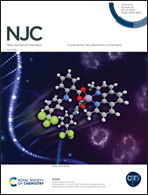1,2,3-Triazolyl bisphosphine with pyridyl functionality: synthesis, copper(i) chemistry and application in click catalysis†
Abstract
This manuscript describes the synthesis and copper(I) complexes of pyridine functionalized 1,2,3-triazolyl bisphosphine, [2,6-{(PPh2)N(Me)(C5H3N)(C2(PPh2)N3C6H5)}] (L), photo-physical studies and catalytic application. The reaction of L with copper salts afforded mononuclear complexes [(CuX){2,6-(PPh2)N(Me)(C5H3N)(C2(PPh2)N3C6H5)}-κ3-P,N,P] (X = Cl, 1; Br, 2; and I, 3). The crystal structures showed highly distorted trigonal pyramidal geometries around copper(I) centers. The UV-visible absorption spectra of complexes 1–3 showed a shoulder band in the range of 255–260 nm along with an intense UV absorption band in the range of 305–315 nm. The shoulder bands are assigned to ligand-based π → π* and n → π* transitions, whereas the intense bands are assigned to metal-to-ligand charge transfer (MLCT) transitions along with halide-to-ligand charge transfer (XLCT) transitions. Copper complexes 1–3 efficiently promoted azide–alkyne cycloaddition under aerobic conditions, with a very low catalyst loading of 0.2 mol% at room temperature to produce regioselective 1,4-triazoles with a large substrate scope. The gram-scale synthesis carried out with various substrates indicated the stability of copper complex 3 during catalytic reactions.



 Please wait while we load your content...
Please wait while we load your content...